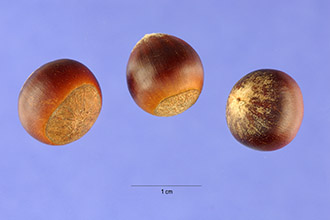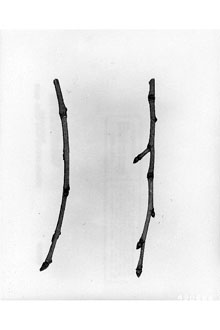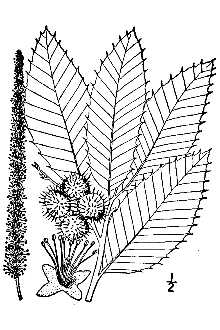Chinquapin
Scientific Name: Castanea pumila (L.) Mill.

| General Information | |
|---|---|
| Usda Symbol | CAPU9 |
| Group | Dicot |
| Life Cycle | Perennial |
| Growth Habits | ShrubTree, |
| Native Locations | CAPU9 |
Plant Guide
Alternate Names
Allegheny chinkapin, American chinquapin, Castanea alnifolia, Castanea ashei, Castanea floridana, Castanea margaretta, Castanea nana, Castanea paucispina, chinquapin, dwarf chestnut, Fagus pumila, golden chinquapin.
Uses
Economic: Chinkapin nuts and wood are sold commercially. The wood is light, hard, close-grained, and strong. It is used for fence posts and fuel although it is not timbered because of its small stature and scattered occurrence. Ethnobotanic: The Cherokee Indians used dried leaves as washes to alleviate headaches, fevers, chills, cold sweats, and fever blisters. The Koasati Indians used the roots of chinkapin as a decoction for stomachaches. Food source: Chinkapin nuts are palatable to humans as well as wildlife. They have a sweet flavor and are often preferred over the fruit of the American chestnut. Landscaping: Chinkapin is sometimes used for landscaping as a small ornamental tree or shrub. Its flowers are attractive but have an unpleasant odor. Male flowers. A.B. Russell. 1997. NC State University. Trees of the Maritime Forest. Restoration: Chinkapin can be used to rehabilitate disturbed sites because of its ability to adapt to harsh conditions. The threat of chestnut blight often deters this decision by land managers. Wildlife: Squirrels, chipmunks, opossums, white-tailed deer, blue jays, woodpeckers and other birds consume chinkapin nuts. White-tailed deer browse the foliage.
Legal Status
Status
Status
Female flowers. G. Nelson. 1996. Shrubs and woody vines of Florida. Chinkapin is rare in its range. It is threatened in Kentucky, endangered in New Jersey, and has been extirpated from most of Alabama by chestnut blight. Please consult the PLANTS Web site and your State Department of Natural Resources for this plant’s current status (e.g. threatened or endangered species, state noxious status, and wetland indicator values).
Description
General: Beech Family (Fagaceae). Chinkapin is a monoecious small tree or large shrub that grows to be 2 to 5 m tall. The twigs are densely hairy (tomentose) when young, becoming shiny brown with densely reddish-hairy buds. The leaves are alternate, simple, short-stemmed, prominently veined, oblong with fine pointed teeth or bristles, up to 15 cm long, and tomentose on the lower surface. Male flowers are borne in the leaf axils, elongated, yellow to white, clustered, and have a strong odor. Female flowers are rounder with a diameter up to 3 cm. The fruit is a spiny bur that houses a single nut. Male flowers appear in May and June, female flowers later in the season. Fruits mature in autumn and winter. Distribution: Chinkapin is native to the eastern and southern United States. Its native range is from New Jersey and West Virginia, west to Missouri and Oklahoma, and south to Texas and Florida. It has been planted in Wisconsin and Michigan where it has become a forest tree. For current distribution, please consult the Plant Profile page for this species on the PLANTS Web site (http://plants.usda.gov). Habitat: Chinkapin occurs in mixed hardwood forests among longleaf pine and scrub oak trees on high ridges and slopes that are free from limestone. It grows on black sandy dunes in the Carolinas, but not on frontal dunes. It is also found on well-drained stream terraces, dry pinelands, and disturbed sites such as railroad rights-of-way, power line clearings, fence and hedgerows, pine plantations, and old fields.
Adaptation
The USDA hardiness zones for chinkapin are 6 to 10. Chinkapin occurs in xeric and mesic sites on dry, rocky, sandy, or loamy soils. It ranges in elevation from sea level to about 1,350 m (4,455 feet). It occurs in open areas and is tolerant of high heat. It is not tolerant of coastal salt spray or shade.
Management
Chinkapin plants form extensive clones where it has been burned annually, It resprouts vigorously following top-kill by fire, It will also regenerate upon overstory removal in stands where it had once been out-competed by canopy trees, Chinkapin is not resistant to herbicides such as 2,4,5-T, bromacil, dicamba, picloram, and silvex, It may resprout following herbicide treatments, , Use soil moisture sensors to measure the soil moisture of Chinquapin.
Pests and Potential Problems
Chinkapin is moderately resistant to chestnut blight, but fewer trees are reported each year due to the inhibitory effects of the fungus.
Seeds and Plant Production
Plant Production
Plant Production
Chinkapin plants and seeds are not commonly produced commercially. It reproduces readily from seed. Collect seeds immediately after the spiny husks have split open to expose the nut. Seeds that are planted in the fall show good germination (>90%) while seeds stored over winter dry out and germinate at reduced rates (<50%). Seedlings will produce nuts in the third growing season, with large nut crops occurring during the fifth and sixth season. Chinkapin also sprouts from rhizomes, forming dense colonies. Cultivars, Improved, and Selected Materials (and area of origin) The NRCS Plant Materials Program has not released chinkapin cultivars for conservation use. The ‘golden’ cultivar is produced for its wildlife value and adaptability to harsh sites. Chinkapin cultivars may be of value for breeding blight-resistant trees with flavorful nuts. Contact your local Natural Resources
Conservation
Service (formerly Soil Conservation Service) office for more information. Look in the phone book under ”United States Government.” The Natural Resources Conservation Service will be listed under the subheading “Department of Agriculture.”
Fact Sheet
Uses
The primary use of chinkapin is for wildlife food and cover. The nuts are an excellent food source during the fall and winter. Squirrels, deer, grouse, bobwhite quail, and wild turkey particularly enjoy the nuts. It can be used as a wildlife component for stabilizing disturbed areas. It can also be planted as a field border, hedgerow, or in backyards and recreational areas.
Status
Please consult the PLANTS Web site and your State Department of Natural Resources for this plant’s current status (e.g. threatened or endangered species, state noxious status, and wetland indicator values).
Description
Allegheny chinkapin is a spreading shrub or small tree reaching a mature height of 20 feet under ideal conditions. The leaves are similar to the Chinese or American chestnut only smaller. They are 3-6 inches long with pointed teeth. The nuts are enclosed in spiny burs about an inch in diameter and golden in color. By contrast, chestnuts are about twice as large and flattened on one side. The nuts of Allegheny chinkapin range from chocolate brown to blackish-brown. Nuts mature in late August in the South and in September and October farther north. Under favorable conditions, seedlings may produce nuts as early as the end of the second or third growing season. However, nut production is not significant until the fourth or fifth year. Six year old plants at the former Quicksand, Kentucky Plant Materials Center produced 1200-1500 nuts per plant. ©William S. Justice Smithsonian Institute @USDA NRCS PLANTS
Adaptation and Distribution
Distribution
Distribution
Allegheny chinkapin is adapted to most soil textures, except heavy clays, It performs best on well-drained soils in full sun or partial shade and worst on poorly-drained soils, Its range of adaptation is from northern Florida, west to Texas and Oklahoma, north to Kentucky, Virginia, Maryland, and along the Atlantic coastal plain to Cape Cod, Massachusetts, Use soil moisture sensors to measure the soil moisture of Chinquapin., For a current distribution map, please consult the Plant Profile page for this species on the PLANTS Website,
Establishment
One year old seedlings should be planted in the early spring. For maximum fruit production, space plants at least eight feet apart in a row to ideally get at least 50% sunlight. When multiple rows are planted, space rows twenty feet apart. When planting in a sod, scalp the area at least three feet across from each plant. Spread a handful of 10-10-10 fertilizer in the bottom of each planting hole and cover with two inches of soil. Do not allow the roots of the plant to contact the fertilizer material when placing in the hole. Mulch each plant with two to four inches of woodchips, sawdust, or straw.
Plant Traits
Growth Requirements
| Temperature, Minimum (°F) | -20 |
|---|---|
| Adapted to Coarse Textured Soils | Yes |
| Adapted to Fine Textured Soils | No |
| Adapted to Medium Textured Soils | Yes |
| Anaerobic Tolerance | None |
| CaCO3 Tolerance | Low |
| Cold Stratification Required | Yes |
| Drought Tolerance | High |
| Fertility Requirement | Low |
| Fire Tolerance | High |
| Frost Free Days, Minimum | 150 |
| Hedge Tolerance | Low |
| Moisture Use | Low |
| pH, Maximum | 6.6 |
| pH, Minimum | 4.5 |
| Planting Density per Acre, Maxim | 1200 |
| Planting Density per Acre, Minim | 300 |
| Precipitation, Maximum | 80 |
| Precipitation, Minimum | 40 |
| Root Depth, Minimum (inches) | 20 |
| Salinity Tolerance | None |
| Shade Tolerance | Intermediate |
Morphology/Physiology
| Bloat | None |
|---|---|
| Toxicity | None |
| Resprout Ability | Yes |
| Shape and Orientation | Erect |
| Active Growth Period | Spring and Summer |
| C:N Ratio | High |
| Coppice Potential | Yes |
| Fall Conspicuous | No |
| Fire Resistant | No |
| Flower Color | Yellow |
| Flower Conspicuous | No |
| Foliage Color | Green |
| Foliage Porosity Summer | Dense |
| Foliage Porosity Winter | Porous |
| Foliage Texture | Coarse |
| Fruit/Seed Conspicuous | Yes |
| Nitrogen Fixation | None |
| Low Growing Grass | No |
| Lifespan | Short |
| Leaf Retention | No |
| Known Allelopath | No |
| Height, Mature (feet) | 20.0 |
| Height at 20 Years, Maximum (fee | 14 |
| Growth Rate | Moderate |
| Growth Form | Multiple Stem |
| Fruit/Seed Color | Brown |
Reproduction
| Vegetative Spread Rate | None |
|---|---|
| Small Grain | No |
| Seedling Vigor | High |
| Seed Spread Rate | Slow |
| Seed per Pound | 250 |
| Fruit/Seed Persistence | No |
| Propagated by Tubers | No |
| Propagated by Sprigs | No |
| Propagated by Sod | No |
| Propagated by Seed | Yes |
| Propagated by Corm | No |
| Propagated by Cuttings | No |
| Bloom Period | Spring |
| Commercial Availability | Routinely Available |
| Fruit/Seed Abundance | Low |
| Fruit/Seed Period Begin | Summer |
| Fruit/Seed Period End | Fall |
| Propagated by Bare Root | Yes |
| Propagated by Bulb | No |
| Propagated by Container | Yes |
Suitability/Use
| Veneer Product | No |
|---|---|
| Pulpwood Product | No |
| Protein Potential | Low |
| Post Product | Yes |
| Palatable Human | Yes |
| Palatable Graze Animal | Low |
| Palatable Browse Animal | High |
| Nursery Stock Product | Yes |
| Naval Store Product | No |
| Lumber Product | No |
| Fuelwood Product | Medium |
| Fodder Product | No |
| Christmas Tree Product | No |
| Berry/Nut/Seed Product | Yes |



